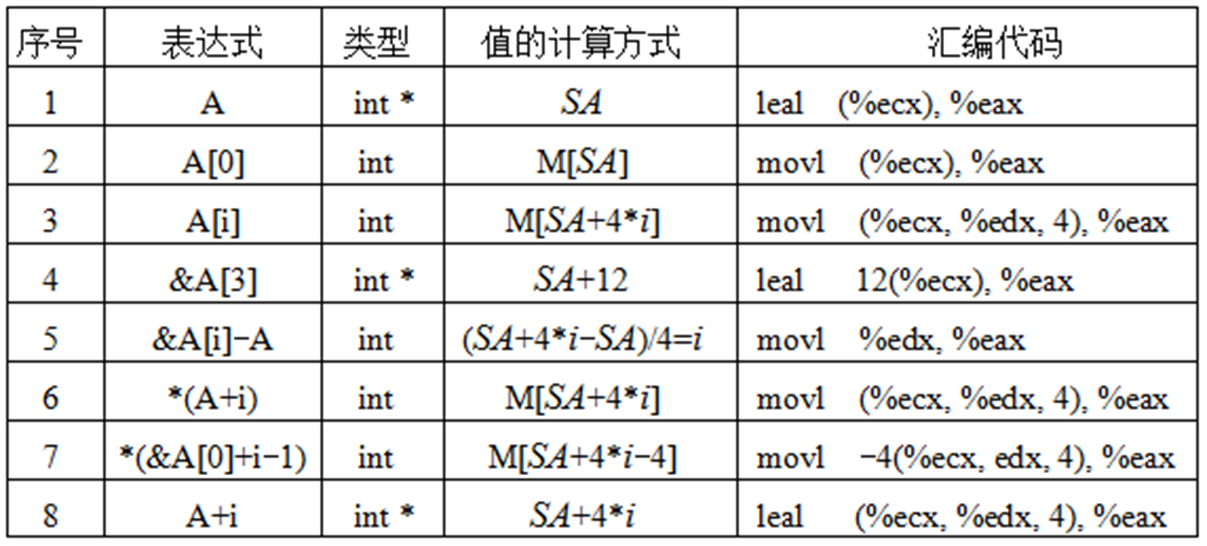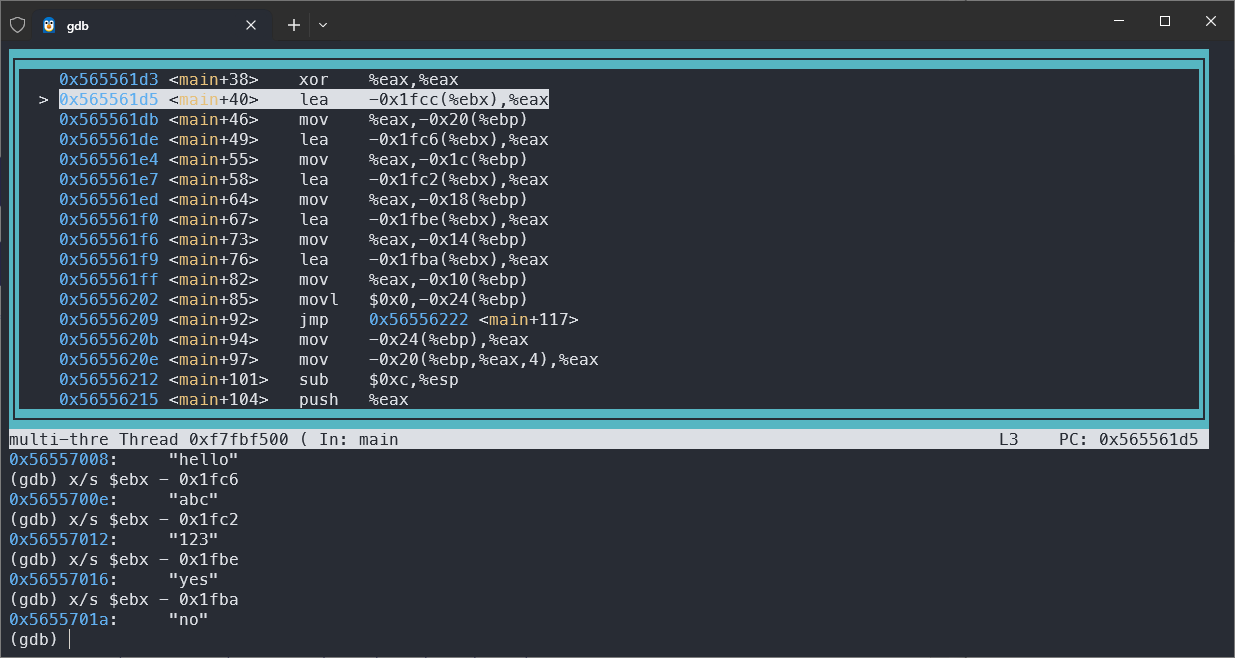Chapter III-5
CSAPP NOTE CHAP III-5
Chap 3.5 复杂数据类型的分配和访问#
地址和指针#
汇编语言中的地址和指针#
- 地址是对主存中的每个字节单元指定一个编号
- 一个数值作为地址使用时通过寄存器进行间接寻址,找到目标操作数。
C 语言中的地址和指针#
- 学过 C 语言都知道,没什么好说的。
- 指针变量,其内容作为间接寻址使用。需要将变量值送到寄存器中进行间接寻址。
数组的分配和访问#
数组的分配是编译程序时进行的。
数组的定义和存储#
数组的存储类型:
- 静态存储
static - 外部存储
extern - 自动存储
auto
auto型分配在堆栈段中,其他类型分配在静态数据区(数据段中)
例如:

数组的访问#
例子
#include <stdio.h>
int main()
{
int a[10];
char b[50] = "1234567";
for (int i = 0; i < 10; i++)
a[i] = i * 3;
for (int j = 0; j < 15; j++)
putchar(b[j]);
return 0;
}汇编代码选摘:
# 初始化 a
11e3: c7 45 ca 00 00 00 00 movl $0x0,-0x36(%ebp)
11ea: c7 45 ce 00 00 00 00 movl $0x0,-0x32(%ebp)
11f1: c7 45 d2 00 00 00 00 movl $0x0,-0x2e(%ebp)
11f8: c7 45 d6 00 00 00 00 movl $0x0,-0x2a(%ebp)
11ff: c7 45 da 00 00 00 00 movl $0x0,-0x26(%ebp)
1206: c7 45 de 00 00 00 00 movl $0x0,-0x22(%ebp)
120d: c7 45 e2 00 00 00 00 movl $0x0,-0x1e(%ebp)
1214: c7 45 e6 00 00 00 00 movl $0x0,-0x1a(%ebp)
121b: c7 45 ea 00 00 00 00 movl $0x0,-0x16(%ebp)
1222: c7 45 ee 00 00 00 00 movl $0x0,-0x12(%ebp)
# 初始化 b (直接把字符串粗暴转化)
# a.c:5: char b[50] = "1234567";
movabsq $15540725856023089, %rax #, tmp97
movl $0, %edx #,
movq %rax, -64(%rbp) # tmp97, b
movq %rdx, -56(%rbp) #, b
movq $0, -48(%rbp) #, b
movq $0, -40(%rbp) #, b
movq $0, -32(%rbp) #, b
movq $0, -24(%rbp) #, b
movw $0, -16(%rbp) #, b
# for 循环内,对 a 和 b 的间接寻址:
a:
# 取出 i
1238: 8b 55 90 mov -0x70(%ebp),%edx
# 对 i 乘以 3
123b: 89 d0 mov %edx,%eax
123d: 01 c0 add %eax,%eax
123f: 01 c2 add %eax,%edx
# 取出 i
1241: 8b 45 90 mov -0x70(%ebp),%eax
# 间接寻址
1244: 89 54 85 98 mov %edx,-0x68(%ebp,%eax,4)
b:
# 取出字符串首地址
125b: 8d 55 c2 lea -0x3e(%ebp),%edx
# 取出索引值
125e: 8b 45 94 mov -0x6c(%ebp),%eax
# 计算偏移后地址
1261: 01 d0 add %edx,%eax
# 将 char 转化为 (unsigned)int
1263: 0f b6 00 movzbl (%eax),%eax
# 冗余代码,因为 putchar 要求传入值为 int,最终又要变为(unsigned)int。编译器在上一步调整完之后没意识到这一点
1266: 0f be c0 movsbl %al,%eax
# 冗余代码,编译器没优化时希望把偏移量凑满 8 位,所以对栈顶调整了数值。
1269: 83 ec 0c sub $0xc,%esp
# eax 入栈
126c: 50 push %eax一维数组数组元素的访问:
- 采用变址寻址
- 数组名作为位移量
- 数组下标放到变址寄存器中
数组和指针#
在指针变量目标数据类型和数组类型相同的前提下,指针变量可以指向数组或数组中任意元素。
例子
#include <stdio.h>
int main()
{
int a[10];
int *ptr1 = &a[0];
int *ptr2 = &a[1];
int *ptr0 = a;
return 0;
}对应汇编片段:
11bc: 8d 44 24 14 lea 0x14(%esp),%eax ; 取出 a[0] 地址给 ptr1
11c0: 89 44 24 08 mov %eax,0x8(%esp)
11c4: 8d 44 24 14 lea 0x14(%esp),%eax ; 取出 a[0] 地址
11c8: 83 c0 04 add $0x4,%eax ; 变址成 a[1] 地址
11cb: 89 44 24 0c mov %eax,0xc(%esp)
11cf: 8d 44 24 14 lea 0x14(%esp),%eax ; 取出 a 地址
11d3: 89 44 24 10 mov %eax,0x10(%esp)对应汇编寻址取值方式:

指针数组和多维数组#
指针数组 数组元素是指针变量的数组,称为指针数组。
例子
#include<stdio.h>
int main() {
char * sa[5] = {"hello", "abc", "123", "yes", "no"};
for(int i = 0; i < 5; i++) {
printf("%s\n", sa[i]);
}
return 0;
}对应汇编代码:
// 这一段用来将五个字符串地址存入指针数组
11d5: 8d 83 34 e0 ff ff lea -0x1fcc(%ebx),%eax
11db: 89 45 e0 mov %eax,-0x20(%ebp)
11de: 8d 83 3a e0 ff ff lea -0x1fc6(%ebx),%eax
11e4: 89 45 e4 mov %eax,-0x1c(%ebp)
11e7: 8d 83 3e e0 ff ff lea -0x1fc2(%ebx),%eax
11ed: 89 45 e8 mov %eax,-0x18(%ebp)
11f0: 8d 83 42 e0 ff ff lea -0x1fbe(%ebx),%eax
11f6: 89 45 ec mov %eax,-0x14(%ebp)
11f9: 8d 83 46 e0 ff ff lea -0x1fba(%ebx),%eax
11ff: 89 45 f0 mov %eax,-0x10(%ebp)
// 接下来是 for 循环
1202: c7 45 dc 00 00 00 00 movl $0x0,-0x24(%ebp) ; 定义 i = 0
1209: eb 17 jmp 1222 <main+0x75> ; 条件跳转
120b: 8b 45 dc mov -0x24(%ebp),%eax ; eax = i
120e: 8b 44 85 e0 mov -0x20(%ebp,%eax,4),%eax
1212: 83 ec 0c sub $0xc,%esp ; esp -= 12, 用来入栈eax
1215: 50 push %eax
1216: e8 45 fe ff ff call 1060 <puts@plt>
121b: 83 c4 10 add $0x10,%esp
121e: 83 45 dc 01 addl $0x1,-0x24(%ebp)
1222: 83 7d dc 04 cmpl $0x4,-0x24(%ebp)
1226: 7e e3 jle 120b <main+0x5e>

多维数组
例子
#include <stdio.h>
int main()
{
char a[3][5];
char *p00 = &(a[0][0]);
char *p01 = &(a[0][1]);
char *p02 = &(a[0][2]);
char *p10 = &(a[1][0]);
char *p11 = &(a[1][1]);
char *p20 = &(a[2][0]);
char *p24 = &(a[2][4]);
return 0;
}对应的汇编代码:
11bc: 8d 44 24 1d lea 0x1d(%esp),%eax ; eax = a
11c0: 89 04 24 mov %eax,(%esp)
11c3: 8d 44 24 1d lea 0x1d(%esp),%eax
11c7: 83 c0 01 add $0x1,%eax ; eax = &a[1]
11ca: 89 44 24 04 mov %eax,0x4(%esp)
11ce: 8d 44 24 1d lea 0x1d(%esp),%eax
11d2: 83 c0 02 add $0x2,%eax ; eax = &a[2]
11d5: 89 44 24 08 mov %eax,0x8(%esp)
11d9: 8d 44 24 1d lea 0x1d(%esp),%eax
11dd: 83 c0 05 add $0x5,%eax ; eax = &a[5]
11e0: 89 44 24 0c mov %eax,0xc(%esp)
11e4: 8d 44 24 1d lea 0x1d(%esp),%eax
11e8: 83 c0 06 add $0x6,%eax ; eax = &a[6]
11eb: 89 44 24 10 mov %eax,0x10(%esp)
11ef: 8d 44 24 1d lea 0x1d(%esp),%eax
11f3: 83 c0 0a add $0xa,%eax ; eax = &a[10]
11f6: 89 44 24 14 mov %eax,0x14(%esp)
11fa: 8d 44 24 1d lea 0x1d(%esp),%eax
11fe: 83 c0 0e add $0xe,%eax ; eax = &a[15]
1201: 89 44 24 18 mov %eax,0x18(%esp)实际上汇编就是把多维数组拆开来看的
结构体数据的分配和访问#
结构体的定义和存储#
C语言的结构体将不同类型的数据依次存放在一段连续的存储区中。指向结构的指针,就是其第一个字节的地址。
结构体的存储类型主要包括:
- 静态存储
static型 - 外部存储
extern型 - 自动存储
auto型
auto 型存储分配在堆栈段中,其他存储类型分配在静态数据区(数据段)中。
结构体成员首址,采用 变址寻址 确定,即
结构体数据作为子程序参数和返回值#
结构体变量按值传递空间和时间开销太大,而且对应的实参无法被调用。因此结构体参数往往按地址传递。
例子
#include <stdio.h>
typedef struct
{
int id;
char name[10];
} stu_info;
void reg_stu_v(stu_info s)
{
s.id = 101;
}
void reg_stu_a(stu_info* s)
{
s->id = 201;
}
int main()
{
stu_info stu = {-1, "jack"};
reg_stu_v(stu);
printf("%d\n", stu.id);
reg_stu_a(&stu);
printf("%d\n", stu.id);
return 0;
}对应汇编代码片段:
000011ad <reg_stu_v>:
11ad: 55 push %ebp
11ae: 89 e5 mov %esp,%ebp
11b0: e8 da 00 00 00 call 128f <__x86.get_pc_thunk.ax>
11b5: 05 1f 2e 00 00 add $0x2e1f,%eax
11ba: c7 45 08 65 00 00 00 movl $0x65,0x8(%ebp) ; 给栈内存里的临时变量赋值
11c1: 90 nop
11c2: 5d pop %ebp
11c3: c3 ret
000011c4 <reg_stu_a>:
11c4: 55 push %ebp
11c5: 89 e5 mov %esp,%ebp
11c7: e8 c3 00 00 00 call 128f <__x86.get_pc_thunk.ax>
11cc: 05 08 2e 00 00 add $0x2e08,%eax
11d1: 8b 45 08 mov 0x8(%ebp),%eax ; 和上一个函数最大的区别,这里调用了传入的指针
11d4: c7 00 c9 00 00 00 movl $0xc9,(%eax) ; 给传入指针对应的实际变量
11da: 90 nop
11db: 5d pop %ebp
11dc: c3 ret
main:
1205: c7 45 e4 ff ff ff ff movl $0xffffffff,-0x1c(%ebp)
120c: c7 45 e8 6a 61 63 6b movl $0x6b63616a,-0x18(%ebp)
1213: c7 45 ec 00 00 00 00 movl $0x0,-0x14(%ebp)
121a: 66 c7 45 f0 00 00 movw $0x0,-0x10(%ebp)
1220: ff 75 f0 push -0x10(%ebp) ; 将成员变量压栈
1223: ff 75 ec push -0x14(%ebp)
1226: ff 75 e8 push -0x18(%ebp)
1229: ff 75 e4 push -0x1c(%ebp)
122c: e8 7c ff ff ff call 11ad <reg_stu_v>
1231: 83 c4 10 add $0x10,%esp
1234: 8b 45 e4 mov -0x1c(%ebp),%eax
1237: 83 ec 08 sub $0x8,%esp
123a: 50 push %eax
123b: 8d 83 34 e0 ff ff lea -0x1fcc(%ebx),%eax ; 把结构体存入 eax
1241: 50 push %eax
1242: e8 09 fe ff ff call 1050 <printf@plt>
1247: 83 c4 10 add $0x10,%esp
124a: 83 ec 0c sub $0xc,%esp
124d: 8d 45 e4 lea -0x1c(%ebp),%eax
1250: 50 push %eax
1251: e8 6e ff ff ff call 11c4 <reg_stu_a>
1256: 83 c4 10 add $0x10,%esp
1259: 8b 45 e4 mov -0x1c(%ebp),%eax
125c: 83 ec 08 sub $0x8,%esp
125f: 50 push %eax
1260: 8d 83 34 e0 ff ff lea -0x1fcc(%ebx),%eax
1266: 50 push %eax
1267: e8 e4 fd ff ff call 1050 <printf@plt>
126c: 83 c4 10 add $0x10,%esp结构体结构:

接下来讨论结构体数据作为返回值:
例子
#include <stdio.h>
typedef struct {
int id;
char name[10];
} stu_info;
stu_info get_stu() {
stu_info stu = {75, "Peter"};
return stu;
}
int main() {
stu_info stu = get_stu();
return 0;
}对应的汇编代码:
# a.c:7: stu_info stu = {75, "Peter"};
movl $75, -48(%rbp) #, stu.id
movabsq $491328398672, %rax #, tmp88
movq %rax, -44(%rbp) # tmp88, stu.name
movw $0, -36(%rbp) #, stu.name
# a.c:8: return stu;
movq -48(%rbp), %rax # stu, tmp83
movq -40(%rbp), %rdx # stu,
movq %rax, -32(%rbp) # tmp83, D.2355
movq %rdx, -24(%rbp) #, D.2355
movq -32(%rbp), %rax # D.2355, tmp84 这里 rax 和 rdx 是返回值,为了方便返回的时候赋值
movq -24(%rbp), %rdx # D.2355,
# a.c:11: stu_info stu = get_stu();
movl $0, %eax #,
call get_stu #
movq %rax, -32(%rbp) # tmp84, stu
movq %rdx, -24(%rbp) #, stu这里返回值为什么用两个寄存器?
- 返回值的标准:
- 对于“简单”的、不超过64位(8字节)的返回值(例如
int,long,char*),调用约定规定只使用%rax寄存器。 - 但是,你的
stu_info结构体大于8字节。int id;// 4 字节char name[10];// 10 字节- 总大小 = 14 字节。
- 为了对齐,编译器可能会把它当作16字节来处理。
- 对于“简单”的、不超过64位(8字节)的返回值(例如
- 针对小型结构体的优化规则: x86-64 ABI 规定:
- 如果一个结构体(或联合体)总大小不超过16字节(128位),它可以直接通过寄存器返回。
- 它会被拆分成两个8字节(64位)的“块”。
- 第一个8字节的块放入
%rax。 - 第二个8字节的块放入
%rdx。
联合体数据的分配和访问#
C 语言中的联合体,各成员共享存储空间,按最大长度成员所需空间大小为目标。成员具有相同的起始地址
#include <stdio.h>
union uarea
{
char c_data;
short s_data;
int i_data;
long l_data;
};
int main()
{
union uarea u;
char* a1 = &(u.c_data);
short* a2 = &(u.s_data);
int* a3 = &(u.i_data);
long* a4 = &(u.l_data);
return 0;
}对应汇编:
11bc: 8d 44 24 08 lea 0x8(%esp),%eax
11c0: 89 44 24 0c mov %eax,0xc(%esp)
11c4: 8d 44 24 08 lea 0x8(%esp),%eax
11c8: 89 44 24 10 mov %eax,0x10(%esp)
11cc: 8d 44 24 08 lea 0x8(%esp),%eax
11d0: 89 44 24 14 mov %eax,0x14(%esp)
11d4: 8d 44 24 08 lea 0x8(%esp),%eax
11d8: 89 44 24 18 mov %eax,0x18(%esp)可见无论把 union 如何解读,取的地址都是 0x8(%esp)
联合体中的变量相互覆盖,起始地址相同。
数据的对齐#
- 若 CPU 同时可以访问读写 64 位主存,则一次可以读写 8 个字节
- 一条指令中操作数的地址按 8 对齐,访问该操作数就只需要一次主存访问,效率会更高。